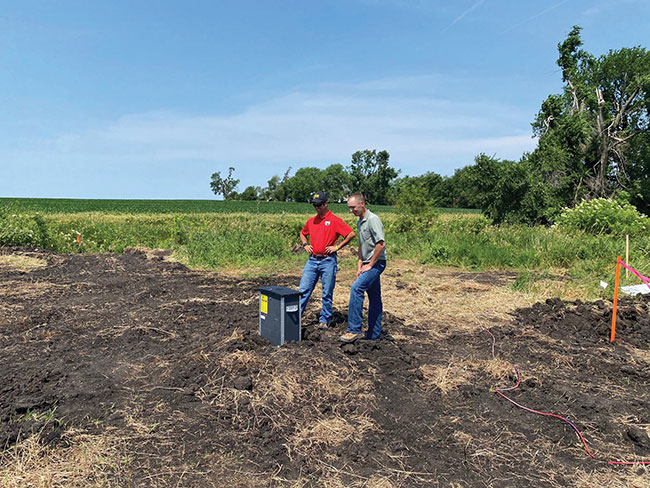
Features
Guest Column
The stage is set
November 7, 2022 By Keegan Kult
 Bioreactors and saturated buffers are a useful tool in the removal of excess nutrients from waterways.
Image courtesy of the ADMC.
Bioreactors and saturated buffers are a useful tool in the removal of excess nutrients from waterways.
Image courtesy of the ADMC. Engagement on the importance of water management has never been higher. The investment by the drainage industry in the Agricultural Drainage Management Coalition (ADMC) has led to new partnerships, completed pilot projects resulting in a scalable amount of practices on the ground, trained a new cohort of contractors and agency personnel on how to design drainage water management systems and perhaps most importantly have raised the industry’s presence among agencies and researchers.
ADMC president, Kent Rodelius, who is Prinsco’s ag market relationship manager, said it best at the recent International Drainage Symposium when he said while there have been large gains in the past couple of years on the advancement of conservation drainage practices, it feels like we are now on the cusp of seeing exponential growth of practice adoption.
Why all this enthusiasm? The need to improve current water management is certainly there. Eric Snodgrass, Nutrien Ag Solutions principal atmospheric scientist, presented at an ADMC-sponsored webinar to the Conservation Drainage Network Growth Committee earlier in the summer about the changing rainfall dynamics. In the Midwest, there are now four to five fewer workable spring field days than in prior years due to an increase in heavy rainfall events. This is somewhat offset by advancements in equipment technology, but there are also additional time demands with the management of practices such as cover crops. We are also experiencing more high intensity rainfall events in the summer often followed by longer dry spells. Not only is there an increased need for water management, but more work has also been done to improve the demand for and delivery of conservation drainage practices.
Advances in automated drainage water management will create demand for the practice by reducing the barriers to adoption of controlled drainage for farmers by eliminating extra trips to the field to manage structures. In addition to eliminating trips to the field, automated drainage water management can provide a portal to track valuable water level data for the farmers. Demand for the practice will truly increase with research that can show consistent yield gains or a reduction in yield variability. There is new research in Ohio to look at historic controlled drainage sites from an early 2000s ADMC Conservation Innovation Grant (CIG). Ecosystem Services Exchange and Ohio State University will update a portion of the previous CIG sites with automated structures to evaluate the yield response to a more adaptive management approach compared to manual structures and conventional drainage systems.
Research is also starting to come out to show the important role conservation drainage systems can play in reducing agriculture’s carbon footprint. Michael Castellano of Iowa State University presented to an ADMC sponsored Conservation Drainage Network Growth Committee webinar on the role drainage and especially conservation drainage can play in the overall balance of greenhouse gas (GHG) emissions for agriculture. Nitrogen fertilizer production is the most energy intensive part of row crop agriculture, and N2O emissions within the field can be the largest drivers on the carbon balance sheet. Being able to determine an economic and agronomical optimum nitrogen rate is difficult as the agronomical optimum nitrogen rate may vary by nearly 100lb N ac-1 from year to year. Drainage can reduce this uncertainty and reduce the overapplication of N by farmers by giving them the confidence to accurately predict the amount of N needed. In fact, research has shown that controlled drainage can reduce the annual variability of the agronomic optimum nitrogen rate for a corn soybean rotation by 75 percent compared to an undrained site. When paired with an edge of field practice such as a saturated buffer, denitrifying bioreactor, or treatment wetland the entire system will become less leaky and more efficient.

Adoption and understanding is on the rise for conservation drainage practices.
Image courtesy of the ADMC.
The timely research is incredibly important as the United States Department of Agriculture (USDA) is investing heavily in agriculture. The USDA has recently announced nearly $3 billion worth of funding for climate smart partnerships. There will also be an increase in funding for traditional financial assistance programs such as EQIP and CSP. It is up to those involved with drainage to step up and deliver on practices and programs and show that the industry can be part of the solution.
Thanks to the investment in ADMC by its members, there is an open dialogue with USDA agency leaders about what is needed to get more practices on the ground. Additionally, the connection to the university researchers is at an all-time high through ADMC’s participation with the Conservation Drainage Network (CDN). ADMC utilizes the research provided by the CDN members to show leadership the importance of the practices. Contracted work on pilot projects such as the Polk County Saturated Buffer project have also provided the blueprint on how alternative practice delivery can lead to scalable implementation of the practices as more than 100 saturated buffers and bioreactors have been installed the past two years in central Iowa. It is incredibly important to show that these solutions are scalable and that with adequate funding and the right delivery mechanisms will be utilized. DC
To learn about opportunities near you or if you are interested in developing a project please reach out to Keegan Kult, Executive Director of ADMC, at kkult@admcoalition.com
Print this page